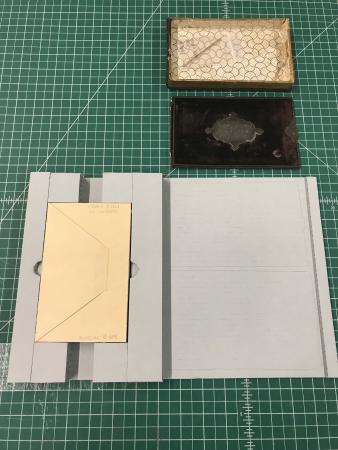Happy Preservation Week! Recently, I had the pleasure of creating a custom housing for a unique object found within Accession 18-009, Frank A. Taylor Papers, 1835-2003. Since space management is always something we take into consideration when rehousing collections, I decided to create a housing that could easily fit within our standard record storage boxes.
The papers contained within the small, fabric-covered, paper-lined box were removed and placed in a four-flap enclosure. Due to the fragility of the box, I knew I wanted to store the contents separately so researchers could easily access the papers without handling the box. However, I still wanted to keep the items together to maintain the association.

Using archival blueboard, I began creating a custom enclosure that would hold all three items – the paper contents, the box base, and the box lid – in a vertical manner, so that it could sit like a folder within a record storage box. The base of the tray was cut to the same dimensions as a legal-size folder. I then began building up the sides and supports of the tray using pieces of blueboard, until the board was level with the height of the four-flap.
On the right side of the enclosure, I created two sections that would hold the box. The blueboard was built up in the same way as with the four-flap. Since the box lid was much shallower in depth than the box base, I added Volara® polyethylene foam to its section to build up the height and add cushioning.
Due to the friability of the paper lining in the box and lid, I covered the entire right side of the tray with Tyvek® in order to create a smooth surface for the box and lid to rest against. This will reduce friction and potential loss of the lining. The Tyvek was secured using double-sided tape.
This tray was then placed inside a blueboard cover. Using three pieces of blueboard – two for the covers and one for the spine – I created a book-like structure to fully encapsulate the inner tray. This would hold all the contents in place once it was stored vertically within the record storage box.

For archival collections, fitting unusual collections within standard size boxes can be a common occurrence. But with a little creativity and thinking outside the box, you can safely fit those collections back in your box!
Related Resources
- "Career advice from our Preservation Coordinator," by Alison Reppert Gerber, The Bigger Picture, Smithsonian Institution Archives
- "A New Solution for an Old Scrapbook," by Alison Reppert Gerber, The Bigger Picture, Smithsonian Institution Archives
- "Pennywise Preservation: Oversized Prints and Drawings," by Alison Reppert Gerber, The Bigger Picture, Smithsonian Institution Archives
- "Perplexing Panmoramas: Taking Charge of Housing Oversized Collections," by Alison Reppert Gerber, The Bigger Picture, Smithsonian Institution Archives
- "Stabilizing Lacquer Transcription Discs," by Alison Reppert Gerber, The Bigger Picture, Smithsonian Institution Archives
Produced by the Smithsonian Institution Archives. For copyright questions, please see the Terms of Use.

Leave a Comment